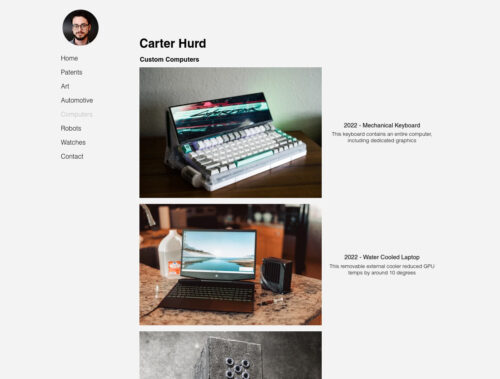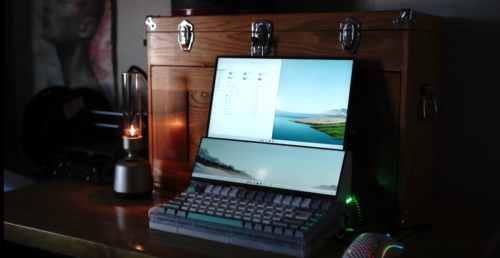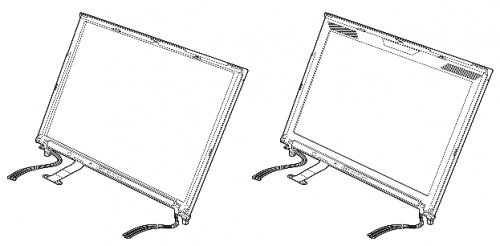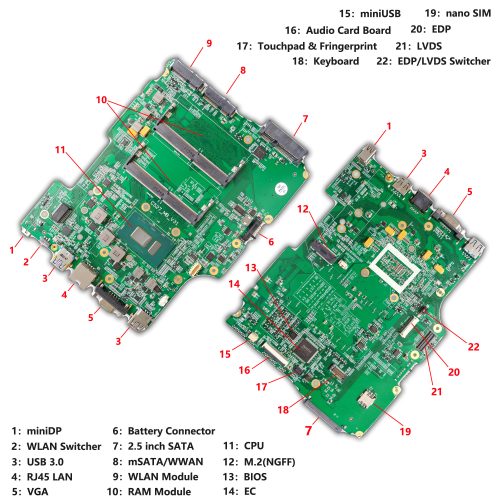Custom computers by Carter Hurd



The idea of a cyberdeck is simple. A relatively portable case that is primarily a keyboard with some screen attached. Cyberdecks often try to hit a particular aesthetic or vibe rather than focusing on usability or practicality. [Carter Hurd] took a step back and asked himself what would be a cyberdeck-like system that he could practically use every day.
The LibreRouter is an Open Source Hardware WiFi Router designed from the ground up for Community Networks.
Based on the the QCA9558 SoC and QCA8337N Gigabit Switch
I’ve managed to cobble together a device that is not only dirt cheap for what it does, but is extremely capable in its own right. If you have any interest in building your own home router, I’ll demonstrate here that doing so is not only feasible, but relatively easy to do and offers a huge amount of utility – from traffic shaping, to netflow monitoring, to dynamic DNS.
I built it using the espressobin, Arch Linux Arm, and Shorewall.
Huh, any idea which ODM?
That’s not something we disclose, and to my knowledge nobody managed to figure out for our existing lineup. Regardless, these aren’t white-box devices we are simply repackaging. We work with an ODM to make customizations to a reference board/design, including (but not limited to) keyboard layout/feel, hardware kill switches, display type, hardware TPM, display type, chassis materials, etc. All of which add significant NRE cost (which we have to pay upfront)
The PinePhone is a smartphone, developed by computer manufacturer Pine64, intended for allowing the user to have full control over the device. Measures to ensure this are running mainline Linux based mobile operating systems, assembling the phone with screws, so that it can be easily disassembled for repairs and upgrades[4], and including six kill switches / security switches for its hardware, which are accessible by removing the back cover of the phone.
I found information about the Squeeze box players, and how they do not make them anymore, then found that you could use your Raspberry Pi with many different distributions to create different types of music players, but none really fit my needs as they required much programing and I did not have the time to «make it work» as I should. Then, out of the many searches trying to find the Logitech Media Server installation, I came across Max2Play. It promised to do everything I needed and wanted along with a few extras as well.
Voilà bien longtemps que je devais revoir mon système audio multiroom complètement, pour avoir quelque chose de plus complet, répondant à mes besoins, de meilleure qualité, et avec un budget maitrisé. Si vous ne connaissez pas le multiroom, c’est en fait un système audio qui permet de sonoriser plusieurs pièces afin de pouvoir écouter la musique qu’on veut, où on veut dans la maison. Je vais vous expliquer ici comment j’ai mis en place ce système audio multiroom à l’aide de Raspberry Pi et cartes audio Hifiberry.

The motherboard is designed as a drop-in replacement for the stock motherboard of the X201 and X201s. This means that every hardware component of the original laptop is guaranteed to work with the newer motherboard, including the display, keyboard, charging port etc.

I have not personally used the ThinkPad X201 over an extended period of time. Despite this fact, during the month I have spent with the X210, it is easy to sense 51nb’s effort in recreating a modern ThinkPad X201. Starting by keeping the exceptionally comfortable 7-row keyboard and TrackPoint, adding support for M.2 and mSATA SSDs, finding the WUXGA upgrade, and topping it off with a user-configurable BIOS to maximise performance with the 8th generation mobile chips, upgradable DDR4 RAM slots, … These all have made the X210 a truly memorable and excellent example among the contemporary laptops.
However, this recreation requires a keen hand to assemble, upgrading the motherboard and display panel is not a job for the faint of heart. The BIOS is not perfect either, especially in regards to power consumption and the battery’s status reporting. Thankfully, this does not deal a fatal blow to its practical usability, and the latter has since been fixed with later BIOS updates.
Our test sample, as mentioned numerous times before, was hastily assembled. Despite this however, the laptop demonstrated great stability even with sustained usage and torture testing. The laptop, perhaps predictably, boots quickly and is highly responsive. Thermal performance is nothing less than staggering, to the point that I have to repeatedly make sure that the thermal measuring tools and software are performing properly.
In conclusion, the X210 is a unicorn in the realm of sub-notebooks: retaining the RJ-11 modem port while extracting the full potential of the 8th generation mobile processors; keeping the comfortable and familiar input devices while adding support for cutting edge technologies like PCIe NVMe SSDs; ensuring support for the original LVDS panels while adding support for greatly improved EDP-interfaced IPS panels… The X210 skillfully combines cutting edge technologies with classic elements that make a ThinkPad great for us enthusiasts. The X210 is not just a bottle of fine wine or a fresh breeze through a medieval castle – it’s really much more than that. A faithful recreation from a passionate community of ThinkPad lovers, that’s what the X210 really is.
The first thing to go was the beloved, clacky, positive-action keyboards, replaced by Macbook-style chiclet keyboards that wore out much faster, but at least the keyboards were easily swapped out when they started to falter. Then came new submicro designs that made swapping keyboards into a one-hour procedure that had to be performed by a professional who would have to virtually totally disassemble the computer.
The same forces made drive-swaps harder and harder. I used to order a Thinkpad with the smallest, cheapest drive available and then throw it away on arrival and replace it with a third-party, 1TB SSD. Now I just order the Thinkpads with 1TB SSDs and pay a premium for them (these custom options can add weeks to the build/delivery time, too) — thankfully, the price-gap on Lenovo’s 1TB SSDs and third party drives has narrowed.
And now, the Thinkpad X-series systems have eliminated their Ethernet ports and require users to carry (and not lose or break) a dongle to use wired internet.
51NB, a group of Chinese enthusiasts buy up classic, pre-Lenovo Thinkpad chassis and manufacturers new motherboards for them with modern CPUs and other hardware. They started with a run of Thinkpad «X62» system (X61s with a new motherboard) and then branched out into Thinkpad «X210″s — an X201 with a Core i7 8550u (4 cores, turbo boost up to 4GHz); 2× DDR4 SODIMM slots; 2× mini PCI Express slots; an M.2 NVMe slot; a 3.5” SATA bay; a 12.6 inch, 2880×1920, 450 nits, wide gamut display; Mini DisplayPort & VGA out; 3× USB 3.1 ports; an SD reader and gigabit Ethernet (no dongle required!).
We often see people funneling their passion into keeping beloved devices in operation long past their manufacturer’s intent. These replacement Thinkpad motherboards (translated) bring old (yet beloved) Thinkpads a much desired processor upgrade. This is the work of the user [HOPE] on the enthusiast forum 51nb. The hack exemplifies what happens when that passion for legendary gear hits deep electrical expertise and available manufacturing. This isn’t your regular laptop refurbishment, [HOPE] is building something new.
So am I happy with my X210? Sure. It serves my needs well enough, and I appreciate its main advantages over other laptops with 8th gen U-series CPUs–the classic keyboard and 1920×1200 display. But if I could go back in time, I might’ve bought a T440p because it has similar performance and battery life for a much cheaper price (and I could recycle my DDR3 RAM from my X220T, too), although its weight and size are detriments as well as the fact that it can only ever go up to 16 GB RAM. Or maybe it would’ve been better to get a brand new T470p, which costs about as much, although it would be missing the «cool factor.»
Setting things up took a while because I couldn’t get away with just installing Ubuntu and then running sudo apt-get update && sudo apt-get upgrade. Power consumption is slightly higher than what would be ideal. BIOS requires Windows (or FreeDOS) to update. Overall a good machine but IMO maybe not worth the high price and hassle.
The X210 is an X201 chassis with:
A Core i7 8550u (4 cores, turbo boost up to 4GHz)
2× DDR4 SODIMM slots. I put 32 GB of RAM in.
2× mini PCI Express slots. There’s an 802.11/Bluetooth card in one. The other is empty but could be used for LTE or a second wireless card.
An M.2 NVMe slot. I put a 2TB SSD in it.
A 2.5” SATA bay. I left it empty, but it’s possible to put a second SSD in.
An upgraded screen (12.6 inch, 2880×1920, 450 nits, wide gamut). The bezel is cut to make room for the 3:2 aspect ratio. There is no webcam.
Mini DisplayPort & VGA out.
3× USB 3.1 ports (no USB-C).
SD card reader.
Gigabit ethernet.
Physical switch to toggle Wifi/Bluetooth.
Headphone & microphone jacks.
Internal microphone & speakers.
The X210 is sold as either a motherboard that you install into your own chassis or as a barebones laptop where you bring your own RAM, SSD, and battery. I got the barebones kit.
The X62 is a niche product, but it really scratches an itch for me. There’s no other way to get a 4:3 matte screen, a great keyboard, and modern performance. My MacBook has become my secondary laptop. I’ve only taken it out of the house once since I got the X62, and that was for my Oregon bikepacking trip.
Los ThinkPad X60 y X61 son máquinas casi legendarias, reverenciadas y amadas por usuarios que las utilizaron (o las siguen usando) con pasión. Aquellos diseños acabaron abandonándose por parte del fabricante, que aun sin descuidar la familia ha preferido aprovechar otras decisiones de diseño y componentes.
Es aquí donde entran los responsables de 51nb, un grupo de usuarios en China apasionados por esos viejos ThinkPad y obsesionados por ponerlos al día. Tanto que han conseguido convertir su afición en negocio, y ahora transforman estos viejos portátiles y los rejuvenecen con mejores pantallas, procesadores, más memoria RAM que nunca y conectividad Gigabit Ethernet. Viejos por fuera, nuevecitos por dentro.
Purism ha desarrollado su propia distribución PureOS, que es un derivado de Debian, que no contiene binarios propietarios y es muy enfocado en seguridad. Purism también trata de upstream su código para que Debian y otras distros puedan aprovechar de sus mejoras. El plan de Purism es posibilitar Linux como una plataforma móvil para que otras empresas también puedan crear celulares y tabletas de Linux.
el Librem 5 será hardware libre y será posible imprimir sus partes plásticos con una impresora de 3D y fabricar su PCB (placa de circuitos).
El Librem 5 es diseñado para luchar en contra de la colección y comercialización de los datos de usuarios, que es el plan de negocios de Google, Facebook, Amazon, Tencent y ahora Microsoft. Esta tendencia maliciosa está aumentando con más uso de los redes sociales del web y la necesidad de entrenar las inteligencias artificiales (AI) con muchos datos de usuarios. La competencia para obtener la mejor AI esta impulsando la recolección de datos personales.
Además Purism esta creando una plataforma llamada “Liberty” para ofrecer servicios web por un precio fijo mensual, para evitar servicios web como los de Google, Facebook, Twitter, Microsoft, etc., que son “gratis”, pero son basados en la comercialización de los datos de usuarios.
Aproximadamente 80% de toda la energía de un aparato móvil es consumido durante su fabricación inicial. Un celular que dura 1,5 años consumirá dos veces más energía por día que un celular que dura 3,3 años, si la energía de fabricación es incluida en el cálculo.
El Librem 5 tendrá una batería removible y una ranura MicroSD para aumentar su memoria. Utilizará una ranura M.2 para conectar a un modem celular que significa que el modem podrá ser cambiado para soportar bandas de otras regiones y las bandas del futuro.
Purism fue fundado como un California Social Purpose Corporation. A diferencia que una organismo sin fines de lucro, Purism puede tener ganancias con tal que no interfieren en su obligación legal de cumplir con el siguiente propósito:
The Corporation shall be devoted to ensuring the security, privacy, and freedom of the users of its products, and the hardware and software offered by Purism shall conform to the philosophy of the Free Software movement.
Sus estatutos incluyen la obligación de publicar todo el código escrito por Purism bajo un “free software license” y todos sus esquemas de hardware bajo un “free hardware license”.
Para promover una industria más ética que respeta los derechos digitales de usuarios, es necesario tener empresas como Purism que pueden impulsar el uso de software libre por toda la cadena de suministro.
VoCore is open hardware and runs OpenWrt/LEDE. It has WIFI, USB, UART, 20+ GPIOs but is only one inch square. It will help you to make a smart house, study embedded system or even make the tiniest router in the world.